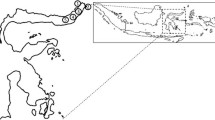Abstract
To clarify the route of Hp transmission in Japan, the serolgical prevalence of Hp infection and its background in the families was examined. For serological study, IgG antibodies against Hp were measured by ELISA, and histories were obtained from the 41 enrolled families (162 people). Upper gastrointestinal endoscopies were performed on selected family members with symtoms, and Hp strains from these families were isolated and RAPD performed to explore the route of Hp infection. Hp prevalence in the 41 families increased with age, and there is strong relationship between Hp serological prevalence and a history of drinking of well water. Among the people who have a history of drinking well water, Hp prevalence in those at least 10 years old was 85.3%, which is significantly higher than that in those less than 10 years old (25%) and no history of drinking well water (6.3%). There were 5 families with Hp serologically positive members who have drunk well water and Hp DNA was detected from the well water of all 5 wells. RAPD fingerprinting of isolated Hp strains from these family members suggested that the origin of Hp infection was the well water. In conclusion, it is speculated that most Hp transmission in Japan depends on waterborne transmission and the occurrence of its transmission is strongly associated with the duration of the history of drinking well water.
Similar content being viewed by others
References
Jones DM, Eldridge J, Whorwell PJ: Antibodies to Campylobacter pyloridis in household contacts of infected patients. Br Med J 294:615, 1987
Ferguson DA Jr, Li C, Patel NR, Mayberry WR, Chi DS, Thomas E: Isolation of Helicobacter pylori from saliva. J Clin Microbiol 31:2802-2804, 1993
Karajden S, Fuksa M, Anderson J, Kempston J, Boccia A, Petrea C, Babida C, Karmali M, Penner JL: Examination of human stomach biopsies, saliva, and dental plaque for Campylobacter pylori. J Clin Microbiol 27:1397-1398, 1989
Thomas JE, Gibson GR, Darboe MK, Dale A, Weaver LT: Isolation of Helicobacter pylori from human faeces. Lancet 340:1194-1195, 1992
Drumm B, Perez-Perez GI, Blaser MJ, Sherman PM: Intrafamilial clustering of Helicobacter pylori infection. N Engl J Med 322:359-363, 1990
Fiedorek SC, Malaty HM, Evans DG, Pumphrey CL, Casteel HB, Evans DJ Jr, Graham DY: Factors influencing the epidemiology of Helicobacter pylori infection in children. Pediatrics 88:578-582, 1991
Graham DY, Malaty HM, Evans DG, Evans DJ Jr, Klein PD, Adam E: Epidemiology of Helicobacter pylori in an asymptomatic population in the United States. Effect of age, race, and socioeconomic status. Gastroeneterology 100:1495-1501, 1991
Klein PD, Graham DY, Gaillour A, Opekun AR, Smith EO: Water source as risk factor for Helicobacter pylori in Peruvian children. Gastrointestinal physiology working group. Lancet 337:1503-1506, 1991
Hulten K, Han SW, Enroth H, Klein PD, Opekun AR, Gilman AR, Gilman RH, Evans DG, Engstrand L, Graham DY, El-Zaatari FAK: Helicobacter pylori in the drinking water in Peru. Gastroenterolgy 110:1031-1035, 1996
Hulten K, Enroth H, Engstrand L: Presence of Helicobacter species DNA in Swedish water. J Appl Microbiol 85:282-286, 1998
Hegarty JP, Dowd MT, Baker KH: Occurrence of Helicobacter pylori in surface water in the United States. J Appl Microbiol 87:697-701, 1999
Karita M, Matsumoto S: Why did the infiltration of the lymphocyte occur in Helicobacater pylori negative case by culture? Jpn J Gastroenterol 96:450, 1999 (in Japanese)
Evans DG, Karjalainen TK, Evans DJ Jr, Graham DY, Lee CH: Cloning, nucleotide sequence, and expression of a gene encoding an adhesin subunit protein of Helicobacter pylori. J Bacteriol 175:674-683, 1993
Tummuru MKR, Cover TL, Blaser MJ: Cloning and expression of a high molecular-mass major antigen of Helicobacter pylori: evidence of linkage to cytotoxin production. Infect Immun 61:1799-1809, 1993
Akopyanz N, Bukanov NO, Westblom TU, Kresovich S, Berg DE: DNA diversity among clinical isolates of Helicobacter pylori detected by PCR-based RAPD fingerprinting. Nucleic Acids Res 20:5137-5142, 1992
Karita M, Tummuru MKR, Wirth HP, Blaser MJ: Effect of growth phase and acid shock on Helicobacter pylori cagA expression. Infect Immun 64:4501-4507, 1996
Atherton JC, Peek RM, Tham KT, Cover TL, Blaser MJ: Clinical and pathological importance of heterogeneity in vacA, the vacuolationg cytotoxin gene of Helicobacter pylori. Gastroenterology 112:92-99, 1997
Asaka M, Kimura T, Kudo M, Takeda H, Mitani S, Miyazaki T, Miki K, Graham DY: Relationship of Helicobacter pylori to serum pepsinogens in an asymptomatic Japanese population. Gastroenterology 102:760-766, 1992
Dooley CP, Cohen H, Fitzgibbons PL, Bauer M, Appleman MD, Perez-Perez GI, Blaser MJ: Prevalence of Helicobacter pylori infection and histologic gastritis in asymptomatic persons. N Engl J Med 321:1562-1566, 1989
Health Division of Ministry of Health and Labor: Environment. In Journal of Health and Welfare Statistics. Health and Welfare Statistics Association, Tokyo, Japan, 2001 p 271(in Japanese)
Author information
Authors and Affiliations
Rights and permissions
About this article
Cite this article
Karita, M., Teramukai, S. & Matsumoto, S. Risk of Helicobacter pylori Transmission from Drinking Well Water Is Higher Than That from Infected Intrafamilial Members in Japan. Dig Dis Sci 48, 1062–1067 (2003). https://doi.org/10.1023/A:1023752326137
Issue Date:
DOI: https://doi.org/10.1023/A:1023752326137




